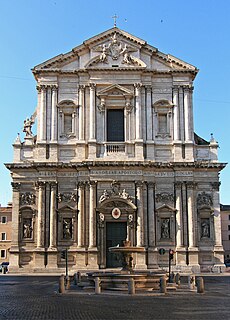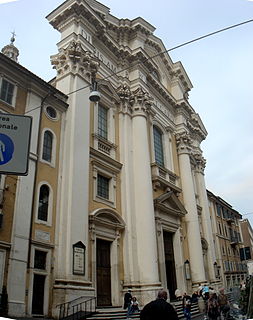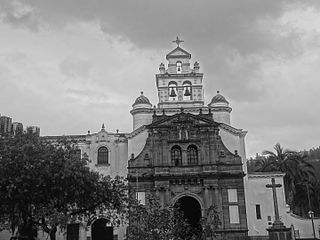
Santa Felicita is a Roman Catholic church in Florence, region of Tuscany, Italy, probably the oldest in the city after San Lorenzo. In the 2nd century, Syrian Greek merchants settled in the area south of the Arno and are thought to have brought Christianity to the region. The first church on the site was probably built in the late 4th century or early 5th century and was dedicated to Saint Felicity of Rome. A new church was built in the 11th century and the current church largely dates from 1736–1739, under design by Ferdinando Ruggieri, who turned it into a one nave edifice. The monastery was suppressed under the Napoleonic occupation of 1808–1810.

The Basilica dei Santi Giovanni e Paolo, known in Venetian as San Zanipolo, is a church in the Castello sestiere of Venice, Italy.

Sant'Andrea della Valle is a minor basilica in the rione of Sant'Eustachio of the city of Rome, Italy. The basilica is the general seat for the religious order of the Theatines. It is located at Piazza Vidoni, at the intersection of Corso Vittorio Emanuele and Corso Rinascimento.

Sant'Ambrogio e Carlo al Corso is a basilica church in Rome, Italy, facing onto the central part of the Via del Corso. The apse of the church faces across the street, the Mausoleum of Augustus on Via di Ripetta.

Paschal Baylón was a Spanish Roman Catholic lay professed religious of the Order of Friars Minor. He served as a shepherd alongside his father in his childhood and adolescence, but desired to enter the religious life. He was refused once but later was admitted as a Franciscan lay brother and became noted for his strict austerities, as well as his love for and compassion towards the sick. He was sent to counter the arguments of the Calvinists in France but was chased out and nearly killed by a mob. He was best known for his strong and deep devotion to the Eucharist.
The year 1747 in architecture involved some significant events.

San Francesco a Ripa is a church in Rome, Italy. It is dedicated to Francis of Assisi who once stayed at the adjacent convent. The term Ripa refers to the nearby riverbank of the Tiber.

Sant'Andrea delle Fratte is a 17th-century basilica church in Rome, Italy, dedicated to St. Andrew. The Cardinal Priest of the Titulus S. Andreae Apostoli de Hortis is Ennio Antonelli.

Santa Maria della Scala is a titular church in Rome, Italy, located in the Trastevere rione. Cardinal Ernest Simoni took possession of the titular church on 11 February 2017. Santa Maria della Scala is a titular church.

The Ss. Stimmate di San Francesco is a church in central Rome, Italy, in the Rione Pigna, sited where previously there was a church called Ss. Quaranta Martiri de Calcarario. It is located on via dei Cestari, near the corner with Corso Vittorio Emanuele II and across the street and diagonal from the Largo di Torre Argentina.

The Basilica of Saints John and Paul on the Caelian Hill is an ancient basilica church in Rome, located on the Caelian Hill. It was originally built in 398.

Charitable institutions attached to churches in Rome were founded right through the medieval period and included hospitals, hostels, and others providing assistance to pilgrims to Rome from a certain "nation", which thus became these nations' national churches in Rome. These institutions were generally organized as confraternities and funded through charity and legacies from rich benefactors belonging to that "nation". Often, they were also connected to national scholæ, where the clergymen of that nation were trained. The churches and their riches were a sign of the importance of their nation and of the prelates that supported them. Up to 1870 and Italian unification, these national churches also included churches of the Italian city states.

San Francesco della Vigna is a Roman Catholic church in the Sestiere of Castello in Venice, northern Italy.

Francisco Preciado de la Vega (1713–1789) was a Spanish painter, active mainly in Italy. He was involved in a number of artists' associations in Rome, both as a member and an officer.

San Bernardino is a church in Verona, northern Italy. The church, in Gothic style, was built from 1451 to 1466.

Salvatore Monosilio was an Italian painter of the 18th century, active in a late-Baroque style in Rome.
Matteo Pannaria or Panaria or Pannerio was an Italian painter of the late-Baroque. He was born in Palermo, Sicily and active both in Rome and Jesi. He painted a Glory of San Giovanni Nepomuceno (1753) for the church of San Giovanni Battista in Jesi. He frescoed the ovals in the ceiling of the church of Santi Quaranta Martiri in Rome. He also painted Beato Giovanni of Prado in one of the chapels.

San Sebastiano is a Baroque-style, Roman Catholic collegiate basilica church located on Piazza Lionardo Vigo in central Acireale in the region of Sicily of Italy. The church became collegiate in 1924; and basilica in 1990.

The church of San Francesco of Assisi is a Catholic religious building in Pavia, Lombardy, Italy.

The Church and Monastery of Our Lady of Guápulo was the first Marian shrine in what is now the Republic of Ecuador, founded in 1620 in Guápulo, a beautiful corner located northeast of the city of Quito, the capital of the country, located at 2,690 meters above sea level. Friar Juan de Dios Navas affirmed that this Shrine is one of the best relics inherited from the Colony. The image of the Virgin of Guápulo was the model used for the sculpture of Our Lady of El Cisne and also that of El Quinche.




















